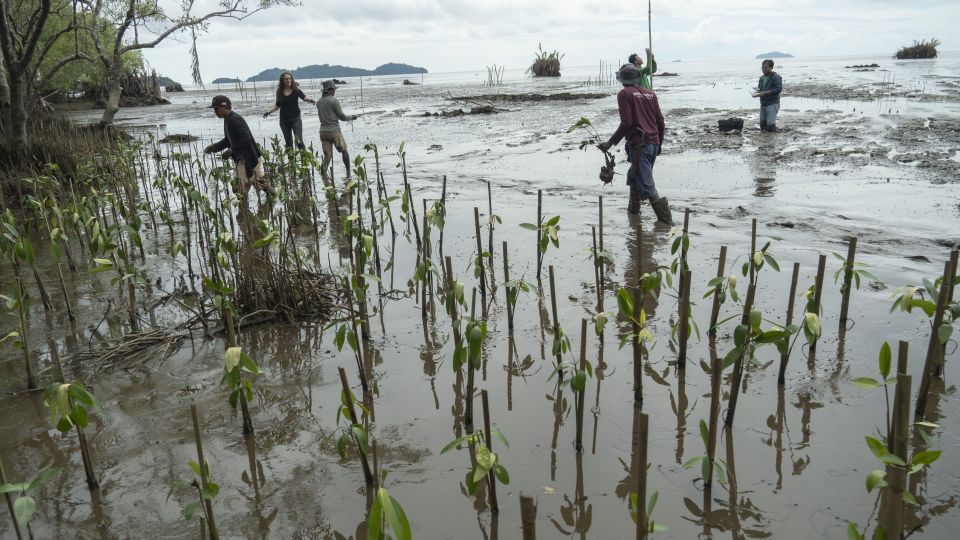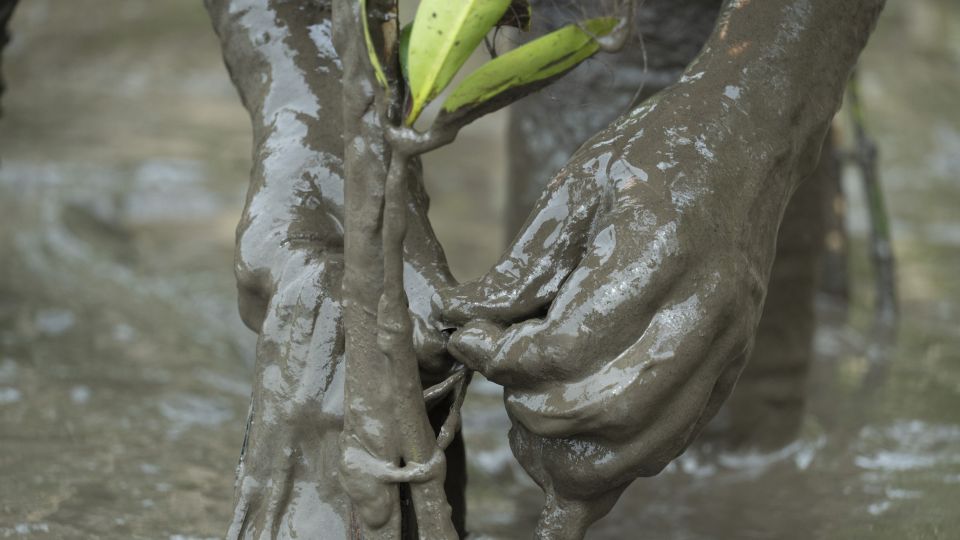Mangroves are not only a rare and spectacular sight, these extraordinary ecosystems are critical to the wellbeing, food security and protection of coastal areas and communities. Located on the boundary between land and sea, mangrove forests are a vital line of defence, acting as a natural buffer and cost-effective means of protecting coastal areas and villages. There are about 80 different species of mangrove trees and shrubs, which grow in areas with low-oxygen soil, where slow-moving waters allow fine sediments to accumulate. Mangroves only grow at tropical and subtropical latitudes near the equator because they cannot withstand freezing temperatures.
Indonesia is home to more mangroves than any other country in the world, and its 3 million hectares of mangrove forests are three times the size of those in Brazil which comes in second. These forests are often recognised by their dense tangle of prop roots which makes it look as though the trees are standing on stilts above the water. The roots allow the trees to handle the daily rise and fall of tides, which means that most mangroves get flooded at least twice a day. The roots also slow the movement of tidal waters, causing sediments to settle out of the water and build up the muddy bottom.
Mangrove forests make up one of the most biologically diverse ecosystems in the world. They provide a valuable nursery habitat for fish and crustaceans and are home to thousands of species of mammals, reptiles and birds.
They act as a form of natural coastal defence against storm surges, saltwater intrusion, tsunamis, rising sea levels and erosion. They also serve as a massive carbon storehouse, storing store up to five times more carbon than any other forest ecosystem.
In short, mangroves are precious. They nurture, nourish and protect life in all its forms.
Yet in spite of the vital role they play in maintaining the health of coastal habitats and communities, mangroves are among the most threatened ecosystems on earth. They have been damaged or destroyed by over-exploitation, deforestation, land reclamation and pollution, land and forest fires and untenable agricultural practices and fisheries. The degradation of mangrove forests is having catastrophic effects on our climate, biodiversity and ecosystems.

Mangrove restoration
Coastal farming communities experience the impact of mangrove loss first-hand. As sea levels rise and more extreme weather events occur as a result of climate change, the risk of seawater ingress destroying crops is very real. Farmers can see for themselves that, where the mangroves are intact, the land is protected, whereas in areas with degraded mangroves, entire harvests have been wiped out by seawater. Earlier efforts to safeguard these ecosystems have had only limited success.
Approximately 40% of the mangrove ecosystems in Indonesia are in Borneo, with a further 30% found in the region of West Kalimantan where YIARI, IAR’s partner in Indonesia, is based.
The approach taken by YIARI to mangrove restoration in Indonesia is, as with all its projects, a holistic one. It is the ‘One-Health’ approach in action. Driven by local communities, the project is protecting nature, boosting biodiversity, enhancing carbon sequestration and growing the local economy to enhance health and prosperity.
The programme provides alternative livelihoods to people in the communities, particularly women who collect seeds, grow seedlings, plant the young trees and tend to them while they become established. Instead of using plastic poly-bags, plastic waste has been eliminated by using biodegradable pots woven from pandanus leaves by local women, which supports gender equality and generates more income for local families.

The mangrove restoration project is complemented by other community projects, such as training in organic farming and sustainable farming practices. All of these actions are designed to improve land use and yields for the local community and reduce dependence on the extraction of natural resources.
The initial pilot project restored 7 hectares of coastal mangrove forests, increasing the resilience and security of coastal communities. The commitment and dedication of the local women led to a 76% survival rate of planted mangrove seedlings - much higher than other similar initiatives in the region.
The aim is to plant at least another 60,000 seedlings by 2024 to halt and reverse mangrove and peat-land degradation, leading to a fully restored, protected and thriving ecosystem for the benefit of animals, people and the environment.

